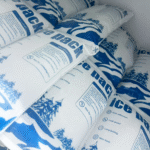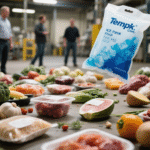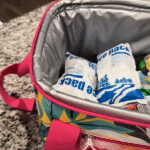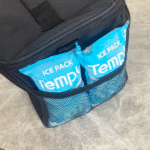Sustainable cold chain packaging is revolutionizing how businesses transport temperature-sensitive products. By adopting eco-friendly materials and smart technologies, you can reduce environmental impact while maintaining product integrity. The reusable cold chain packaging market is projected to reach $4.97 miliar masuk 2025, nearly doubling by 2034, making sustainability a strategic imperative for forward-thinking companies.

– What sustainable cold chain packaging means for your business operations?
– How can you implement eco-friendly packaging without compromising product safety?
– What are the key benefits and challenges of sustainable cold chain solutions?
– Yang 2025 trends will shape the future of temperature-controlled logistics?
– How can you select the right materials for your specific needs?
## What Is Sustainable Cold Chain Packaging and Why Does It Matter?
**Sustainable cold chain packaging uses eco-friendly materials and systems to maintain temperature control while minimizing environmental impact.** This approach replaces traditional plastics and foam with biodegradable, dapat didaur ulang, or reusable alternatives that protect your temperature-sensitive products during storage and transportation. Untuk bisnis Anda, this means reducing packaging waste, lowering disposal costs, and aligning with sustainability goals without compromising product safety.
When you think about cold chain packaging, it’s not just about keeping items at the right temperature—it’s about doing so with fewer environmental trade-offs. Modern sustainable solutions provide equivalent or superior protection compared to traditional options while helping you meet evolving regulatory requirements and consumer expectations. By switching to recyclable or returnable insulated containers, you can significantly reduce landfill burden while maintaining the precise temperature control your products require.
### How Sustainable Packaging Works in Real-World Applications
Sustainable cold chain packaging utilizes innovative materials and designs that maintain temperature integrity while being kinder to the environment. These systems typically incorporate biodegradable insulation, wadah yang dapat digunakan kembali, and energy-efficient solutions that reduce reliance on petroleum-based products. The key advantage for your business is that these solutions often integrate smart monitoring technology, allowing you to track temperature and humidity in real-time while reducing packaging waste.
Many companies find that sustainable packaging actually enhances their operational efficiency. Wadah yang dapat digunakan kembali, misalnya, can be tracked and managed across multiple shipments, creating a closed-loop system that reduces both costs and environmental impact. Advanced materials like phase change materials (PCMS) and aerogel insulation provide superior thermal performance with less material, offering better protection for your pharmaceuticals, produk makanan, or chemicals while minimizing your carbon footprint.
## How Can You Implement Sustainable Cold Chain Packaging?
**Begin by auditing your current packaging usage and identifying specific areas for improvement.** This practical approach helps you understand your baseline performance and set measurable sustainability targets. Focus first on high-volume shipment routes where switching to reusable or recyclable packaging can deliver the quickest returns while maintaining product integrity throughout the transportation process.
A structured implementation plan typically involves selecting pilot shipments, measuring performance against key metrics, and then scaling successful approaches across your operations. The most effective strategies combine material selection with process optimization, ensuring that your sustainable packaging not only protects products but also integrates smoothly into your existing logistics workflow. This methodical approach minimizes risk while maximizing both environmental and economic benefits.
### Creating Your Sustainable Packaging Strategy
| Implementation Phase | Key Actions | Expected Benefits for Your Business |
|———————-|————-|————————————-|
| **Assessment** | Audit current packaging, measure disposal costs | Identify cost-saving opportunities, establish baseline |
| **Pilot Testing** | Select specific routes, test sustainable alternatives | Validate performance, calculate ROI before full implementation |
| **Full Implementation** | Scale successful solutions, staf kereta | Reduce waste by 30-40%, lower long-term packaging costs |
| **Continuous Improvement** | Monitor usage, optimize container return logistics | Maintain performance, identify additional efficiency gains |
### Practical Implementation Tips
– **Untuk pengiriman farmasi:** Start with routes having consistent temperature requirements and implement reusable containers with integrated temperature monitoring.
– **For food products:** Focus on high-volume perishable items and transition from single-use foam coolers to returnable insulated boxes.
– **For chemical transport:** Begin with less sensitive products to validate performance before expanding to more critical shipments.
> **Kasus Dunia Nyata:** A pharmaceutical company switched to sustainable packaging for global vaccine distribution, using biodegradable materials and reusable containers. They reduced packaging waste by 40% and lowered operational costs by 25% within the first year while maintaining perfect temperature control throughout their supply chain.
## What Are the Key Benefits and Challenges?
**Sustainable cold chain packaging delivers significant environmental and economic advantages while presenting manageable implementation challenges.** The most immediate benefit for your business is reduced packaging waste, which directly translates to lower disposal costs and improved compliance with evolving environmental regulations. Selain itu, companies adopting green practices often experience enhanced brand reputation and increased customer loyalty among environmentally conscious consumers.
While the transition requires careful planning, the long-term savings typically outweigh initial investments. Sistem pengemasan yang dapat digunakan kembali, misalnya, may have higher upfront costs but deliver substantial savings over multiple uses. The key is to view sustainable packaging not as an expense but as a strategic investment that improves both your environmental footprint and your bottom line through reduced material costs and waste management expenses.
### Navigating Implementation Challenges
The primary challenges in adopting sustainable cold chain packaging include initial investment requirements, material availability in some regions, and ensuring regulatory compliance—particularly for pharmaceuticals. Namun, these hurdles can be effectively managed through phased implementation, supplier collaboration, and thorough testing. Many companies find that partnering with experienced packaging providers accelerates the transition while minimizing risks.
Your implementation strategy should address these challenges directly by starting with pilot programs, building relationships with reliable sustainable material suppliers, and thoroughly validating packaging performance before full-scale deployment. This approach allows you to demonstrate ROI on a smaller scale, build organizational confidence, and develop the internal expertise needed to expand sustainable practices across your operations.
## Apa 2025 Trends Will Shape Sustainable Cold Chain Packaging?
**The sustainable cold chain packaging landscape is evolving rapidly, dengan 2025 bringing significant advancements in materials, teknologi, and regulatory frameworks.** These developments are making eco-friendly solutions more accessible, efektif, and economically viable than ever before. Untuk bisnis Anda, staying ahead of these trends means maintaining competitive advantage while meeting increasing customer and regulatory expectations for sustainability.
The overall sustainable packaging market is projected to reach $126.50 miliar masuk 2025, berkembang menjadi $240.52 miliar oleh 2034, reflecting the accelerating adoption of eco-friendly solutions across industries. In the cold chain specifically, packaging is expected to grow from approximately $31.69 miliar masuk 2024 ke $35.49 miliar masuk 2025, demonstrating the critical importance of temperature-controlled sustainability in the modern supply chain.
### Kunci 2025 Perkembangan
– **Advanced Biodegradable Materials:** New plant-based foams and mushroom-based packaging offer commercial-grade insulation while breaking down safely after use, reducing your environmental footprint.
– **Integrasi Pengemasan Cerdas:** IoT sensors and data analytics embedded directly in packaging provide real-time condition monitoring, helping you prevent product loss while optimizing packaging performance.
– **Model ekonomi melingkar:** More companies are adopting closed-loop systems where packaging is reused multiple times, significantly reducing waste and resource consumption throughout your supply chain.
– **AI-Powered Optimization:** Artificial intelligence is being deployed to predict temperature excursions and suggest real-time solutions, enhancing both sustainability and reliability in your cold chain operations.
The convergence of these trends means that sustainable packaging is no longer an optional extra but a baseline expectation from customers, regulators, and stakeholders. Companies that proactively adopt these innovations position themselves as industry leaders while building more resilient, efisien, and cost-effective supply chains for the future.
## Pertanyaan yang sering diajukan
**What exactly makes cold chain packaging sustainable?**
Sustainable cold chain packaging uses materials that are reusable, dapat didaur ulang, or biodegradable while maintaining required temperature ranges. This includes plant-based polymers, recycled insulation, and durable containers designed for multiple uses, all of which help reduce environmental impact without compromising product protection.
**Does switching to sustainable packaging risk product integrity?**
Not when properly implemented. Many sustainable materials now match or exceed traditional options in thermal performance. The key is thorough testing and validation specific to your products and shipping conditions, ensuring the new packaging provides equivalent or better protection throughout your supply chain.
**How soon should we start tracking packaging sustainability metrics?**
Begin immediately. Establish a baseline of your current packaging usage, disposal volumes, and associated costs this year, then set measurable improvement targets for the next 12 bulan. Early adopters typically see the quickest returns and avoid playing catch-up as regulations tighten.
**What are common cost considerations when switching to sustainable packaging?**
Initial investment for reusable containers and reverse logistics infrastructure are the primary costs. Namun, these are typically offset within 12-18 months through reduced disposal fees, lower per-shipment packaging costs, and decreased regulatory compliance expenses.
**Can reusable packaging work for ultra-cold shipments (-70° C.)?**
Ya, specialized reusable containers are available for ultra-cold applications. These require careful validation of thermal performance and container lifecycle, but they can provide excellent protection while significantly reducing waste compared to single-use alternatives.
## Ringkasan dan Rekomendasi
Sustainable cold chain packaging offers a powerful opportunity to enhance your supply chain efficiency while reducing environmental impact. The key takeaways include the significant cost savings achievable through reusable systems, the improving performance of eco-friendly materials, and the growing regulatory imperative for sustainable practices. By adopting these solutions, you position your business as an industry leader while building a more resilient and cost-effective operation.
To begin your sustainability journey, conduct a packaging audit this quarter to identify improvement opportunities. Select one high-volume shipment route for a pilot program next month, setting quantifiable targets like reducing single-use waste by 30% by year-end. Engage suppliers who specialize in sustainable solutions, and monitor results monthly to continuously optimize your approach. These practical steps will deliver measurable benefits while future-proofing your cold chain operations.
## Tentang tempk
Dan Tempk, we specialize in advanced temperature-controlled solutions designed for sustainability and performance. Our packaging systems combine durable, reusable containers with integrated monitoring technology, helping you maintain product integrity while significantly reducing environmental impact. We focus on practical innovations that deliver both ecological and economic benefits, ensuring your cold chain operations meet tomorrow’s standards today.
**Contact us today** to schedule a packaging review and discover how our sustainable solutions can transform your supply chain efficiency while reducing your environmental footprint.























